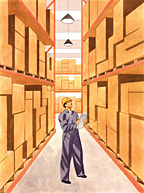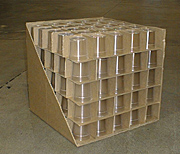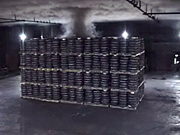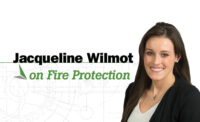
The design and construction of storage facilities have changed in recent years as a result of the availability of innovative concepts and configurations used to store and distribute products. The wide variety of storage systems available today is intended to provide for a safe and cost-effective means to store and move products or materials within a facility. Many storage configurations create unique and formidable challenges related to conducting a fire risk assessment and determining the appropriate fire protection design for the facilities.
To make the most efficient use of space, products and materials are being stored higher and in closer proximity to each other, which can increase the fire challenge significantly. Furthermore, to reduce labor expenses, automated storage systems are becoming increasingly popular. These systems have the ability to move and store a large quantity of products within a facility with a relatively small number of employees. Many warehouses are constructed to accommodate storage over 25 feet high, with some systems designed to store products and materials over 100 feet high.
Sprinkler systems are one of the most effective tools available to provide fire protection for these facilities. The Standard for the Installation of Sprinkler Systems, NFPA 13, published by the National Fire Protection Association (NFPA) provides sprinkler system design and installation criteria for many storage arrangements. However, there are a number of commodities and storage configurations that create fire challenges that are not clearly addressed in NFPA 13 or fall outside the scope of the requirements in the standard. While fire modeling, small-scale fire testing and burning characteristic assessments are useful to obtain a better understanding of the potential fire challenges represented in these facilities, large-scale fire testing that closely simulates the actual storage configuration used in a facility provides a powerful tool to further validate a fire protection design.

UL's Test Facilities
In 1996, UL completed construction on a 45,000-sq.-ft. fire test facility that is designed to simulate a wide range of fires that may occur in large warehouses.The design of this large-scale test facility had the following objectives:
- To provide the ability to evaluate the performance of automatic fire sprinklers intended to protect storage-type fire risks using large-scale fire test scenarios;
- To enable the assessment of fire risks associated with different storage practices and burning commodities; and
- To provide the ability to evaluate the performance of a variety of products and systems in a large test scale scenario, such as plastic pallets, intermediate bulk containers, foam systems, dry-pipe systems and the like.
The primary test cell, where large-scale tests are conducted with fire sprinklers, measures almost 15,000 sq. ft. To appropriately simulate a fire occurring in a large warehouse with sprinkler protection, test arrays typically do not need to exceed 1,500 sq. ft.
Ceiling height and clearance from the sprinkler to the commodity can influence the effectiveness of sprinkler protection. One of the most unique features of this facility is a 100-ft.-by-100-ft. movable ceiling that can be adjusted from heights of 6 ft. up to 48 ft. from the floor. The 10,000-sq.-ft. ceiling is much greater in square footage than the design area for sprinkler system protection, which in many cases is not more than 2,000 sq. ft. The movable ceiling also has special features that allow for flexibility in establishing design criteria relative to sprinkler test spacing and location.
To adequately supply the sprinkler system, the facility features a 200,000-gallon water supply reservoir with a pumping system capable of delivering water at a flow in excess of 6,000 gpm.
In a separate test cell, a 25-ft. diameter calorimeter having a 10-megawatt (MW) capacity is available to measure the rate of heat release and assess fire suppression characteristics of burning commodities. For some products and storage configurations, this test cell can be used as a tool to characterize the fire risk classification for commodities as referenced in NFPA 13, so that an appropriate sprinkler system design can be selected for the facility. See Figure 1 for an illustration of a test to determine the amount of water required to suppress a Class II commodity, as referenced in NFPA 13.
Large-scale fire testing creates the potential to generate large quantities of air and water pollutants. A substantial portion of the total construction and operating costs for UL's test fire facility are related to pollution control. The integrated air pollution control system has a capacity of 60,000 cfm to properly clean airborne contaminants generated during the fire combustion process. The water treatment system is sized proportionally to the water supply reservoir to accommodate contaminated water discharged from each test. Organizations sponsoring tests in UL's facilities have a level of assurance that the external environment will not be adversely impacted by the conduct of large-scale fire tests.
Due to its innovative design and features, this facility was awarded the prestigious Illinois Engineering Council's 1996 Project of the Year Award.

Applications for Large-Scale Fire Testing
Certification of Sprinklers and Other Products
For most sprinklers intended to protect storage facilities, a series of large-scale tests are required by UL to evaluate the ability of the sprinkler to provide the level of protection specified in the UL listing. With the availability of UL's fire test facility, there has been a notable acceleration in the development of storage sprinkler technology. Some sprinklers are UL listed for the protection of rack-stored commodities up to 40 ft. in a 45-ft.-high building with ceiling-only sprinkler protection. Currently, there are 16 different sprinklers (characterized by nominal K-factor, style and type) that are certified and referenced in NFPA 13 for use in storage applications. Most of these products have been developed within the last 10 years.

In addition to the certification of sprinklers, large-scale fire testing with sprinkler protection provided is used to investigate and certify plastic pallets and intermediate bulk containers. It is expected that additional applications for large-scale fire testing related to product certification will be developed in the future

Research and Validation of Performance-Based Designs
The primary fire test cell is used to develop and validate new fire suppression technologies. Research conducted in this facility has included the development of foam systems to fight large hydrocarbon fuel fires as they may occur onboard ships and aircraft carriers; the evaluation of the performance and interaction of smoke/heat vents and sprinklers; strategies to suppress challenging fires, such as pool chemicals and rubber tires (see Figure 4); and assessments of ceiling sprinkler efficacy for unique storage arrangements that are found in today's product distribution and retail environment.In addition, the primary cell is also used to develop fundamental data regarding the water discharge characteristics of sprinklers under fire and non-fire conditions. This data is a valuable tool to assist sprinkler manufacturers in developing more effective products.
The 10-MW calorimeter is an extremely useful apparatus to measure the fire hazards posed by stored commodities that are not clearly understood or not clearly identified in an existing standard. The results of this type of testing may enable parties such as property owners, engineering consultants and authorities having jurisdiction (AHJs) to develop appropriate fire protection strategies.
A combination of testing conducted in the primary test cell and 10-MW calorimeter is often used to develop customized fire protection solutions. The data from the calorimeter can be used to create numerical simulations by applying three dimensional fire models to better understand the complex interactions among the commodities' burning characteristics in the storage arrangement. During the previously referenced research project to develop a better understanding of the interaction of smoke/heat vents and ceiling sprinklers in storage facility fires, a combination of large-scale fire testing and state-of-the-art numerical fire modeling was utilized.
Assessment of Unique Fire Risks
The availability of large-scale fire test facilities of this type permits the fire protection community to develop effective strategies to appropriately protect unique fire risks. Several investigations have been conducted to assess the protection afforded for unique products or storage arrangements that create unusual fire challenges. These assessments have included plastic automotive parts stored in customized rack configurations and a variety of paper products arranged in end-use storage configurations. Many of the solutions developed for these fire risks are limited to the specific conditions investigated during the testing program. Others may have a wider relevance if the test arrangements are representative of more commonly used storage practices in the field.Summary
The trend to construct products from materials having a high level of combustibility, along with the use of innovative storage configurations and systems in warehouses today, have created fire protection challenges that are much greater than those in the past. Publications such as Fire Protection of Storage Facilities, a handbook published by the NFPA, provide useful sources of information related to basic warehouse fire risks. However, the job of determining that adequate fire protection is being provided for storage facilities is becoming more difficult and complex.Large-scale tests simulating fire scenario conditions that may occur in a warehouse facility provide a valuable, data-based tool to property owners, designers, insurance organizations, authorities having jurisdiction and others in assessing the specific risk associated with these fires, as well as the protection afforded by a sprinkler system. When questions arise in the field related to the adequacy of an existing fire protection system design or the appropriateness of a new design concept, the large-scale fire test option may be the most viable approach to address these issues.
Editor's Note: The UL Large-Scale Test Facility will be a part of the tour of UL facilities during the ASPE Technical Symposium in October 2005. Contact ASPE at www.aspe.org for additional information on the Technical Symposium and to sign up for the UL tour.
